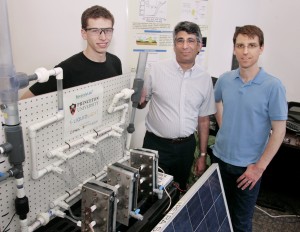By Tien Nguyen, Department of Chemistry
Research to curb global warming caused by rising levels of atmospheric greenhouse gases, such as carbon dioxide, usually involves three areas: Developing alternative energy sources, capturing and storing greenhouse gases, and repurposing excess greenhouse gases. Drawing on two of these approaches, researchers in the laboratory of Andrew Bocarsly, a Princeton professor of chemistry, collaborated with researchers at start-up company Liquid Light Inc. of Monmouth Junction, New Jersey, to devise an efficient method for harnessing sunlight to convert carbon dioxide into a potential alternative fuel known as formic acid. The study was published June 13 in the Journal of CO2 Utilization.

The transformation from carbon dioxide and water to formic acid was powered by a commercial solar panel provided by the energy company PSE&G that can be found atop electric poles across New Jersey. The process takes place inside an electrochemical cell, which consists of metal plates the size of rectangular lunch-boxes that enclose liquid-carrying channels.
To maximize the efficiency of the system, the amount of power produced by the solar panel must match the amount of power the electrochemical cell can handle, said Bocarsly. This optimization process is called impedance matching. By stacking three electrochemical cells together, the research team was able to reach almost 2 percent energy efficiency, which is twice the efficiency of natural photosynthesis. It is also the best energy efficiency reported to date using a man-made device.
A number of energy companies are interested in storing solar energy as formic acid in fuel cells. Additionally, formate salt—readily made from formic acid—is the preferred de-icing agent on airplane runways because it is less corrosive to planes and safer for the environment than chloride salts. With increased availability, formate salts could supplant more harmful salts in widespread use.
Using waste carbon dioxide and easily obtained machined parts, this approach offers a promising route to a renewable fuel, Bocarsly said.
This work was financially supported by Liquid Light, Inc., which was cofounded by Bocarsly, and the National Science Foundation under grant no. CHE-0911114.
White, J. L.; Herb, J. T.; Kaczur, J. J.; Majsztrik, P. W.; Bocarsly, A. B. Photons to formate: Efficient electrochemical solar energy conversion via reduction of carbon dioxide. Journal of CO2 Utilization. Available online June 13, 2014.


You must be logged in to post a comment.